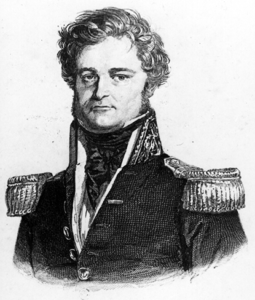Visits to the Marianas

French explorer Jules Sébastien César Dumont d’Urville lead two French Navy expeditions into Oceania. Beginning in April 1826 to February 1829, d’Urville accompanied the corvette Astrolabe through Australia and Oceania. Following his return to his homeland, the government printed the navigational routes and scientific discoveries of d’Urville and other members aboard the vessel. Eight years later and now a captain, d’Urville commanded two corvettes on a much more ambitious course to reach Antartica. Between September 1837 and November 1840, Astrolabe and a new ship, la Zelee, made the rounds once again.
Recuperation on Guam
D’Urville is valuable for his insights into the island’s decline during the interval of his visits. He also was the first explorer to use the term “Micronesia” (one of three geographic regions in Oceania with the other two being Polynesia and Melanesia) in his writings, a term which was coined earlier by French geographer, Domeny de Rienzi.
During his first trek, the crew made a stop on one of the Solomon Islands, but fell sickly shortly after, forcing the Astrolabe to change its course in order to find a place where the crew could receive treatment. Several crew members died when they finally reached landfall on Guam.
As was common knowledge of the time, the Spanish settlements in Guam were the only “true” European ports in the vast Pacific. Scientist Louis Claude de Freycinet had earlier recorded and shared his observations of the island with the French, so the Astrolabe knew that civilization, in their perspective, was available. Ship crews also knew that the island would be equipped to help the sick because of the frequent Spanish galleon stops made between Mexico and the Philippines.
Initially attempting a landing at Apra in the south east coast of Guam, the crew decided upon the more southerly port of Humåtak because it’s bay was deeper. Before coming ashore respects were paid to the Spanish governor Don José de Medinilla. D’Urville knew he would be welcome because of the peace between the Spanish and French courts.
Asking permission to recuperate for three weeks, d’Urville was warmly welcomed by Medinilla. Freycinet’s records show that Medinilla hosted the sick in an unused monastery, provided ample food and supplies and allowed the scientists aboard to conduct their experiments throughout the island. The two men got on so well that d’Urville bestowed the decoration of French Legion of Honor on Medinilla.
D’Urville and his crew arrived at Guam after the island had suffered a four-month drought and much resource exploitation by British whalers. Nevertheless, d’Urville was granted permission to stay at the governor’s official residence and his crew was nursed back to health.
Some trading was done, in particular blue and red calico scarves and gunpowder, for food and supplies.
Return to Guam
Ten years later, d’Urville returned to Guam after a brief stay in the Caroline Islands. Bouts of fever had struck the crew again, leading d’Urville to seek out his old friend Medinilla. Upon landing, the crew learned of the by now retired Medinilla’s death in the Phillipines five years prior.
D’Urville was shocked that Spain’s decline of power in the region as reflected in the appearance of Guam. The fort no longer had cannons, the monastery that housed them previously was in shambles, and the population was suffering from poverty. Whereas, Medinilla had lived extravagantly, the current governor was significantly less well off which may have been due to the loss of the monopoly that Spanish governor’s had on all imported goods by this time.
In spite of the island’s impoverished state, the Spanish attempted to provide the proper protocol for a visiting ship by selling the crew pigs and various fruits.
For further reading
Dumont d’Urville, Jules-Sébastien-César. Two Voyages to the South Seas. Translated and retold by Helen Rosenman. Honolulu: University of Hawai’i Press, 1992.
Freycinet, Louis Claude Desaulses de. An Account of the Corvette L’Uraine’s Sojourn at the Mariana Islands, 1819. Translated by Glynn Barratt. Saipan: Commonwealth of the Northern Mariana Islands Division of Historic Preservation, 2003.
Rogers, Robert. Destiny’s Landfall: A History of Guam. Honolulu: University of Hawai’i Press, 1995.
Sharp, Charles Andrew. “d’Urville, Jules Sébastien César Dumont.” In Te Ara: An Encyclopaedia of New Zealand. Edited by A.H. McLintock, 1966.
